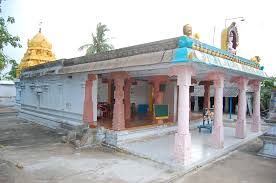Introduction: Discovering Karanthai Digambar Jain Temple
Nestled in the serene village of Karanthai in Tamil Nadu, the Digambar Jain temple stands as a testament to the enduring legacy of Jainism in the region. Dating back to the 9th century, this temple is not only a place of worship but also a beacon of historical and architectural significance. For spiritual seekers and history enthusiasts alike, the Karanthai Digambar Jain Temple offers a unique glimpse into the past, blending devotion with artistry.
Historical Significance of Karanthai Digambar Jain Temple
Karanthai, historically known as Munigiri due to the residence of numerous Jain ascetics, has been a significant center for Jainism since the 8th century. The temple complex is associated with the revered Jain logician Acharya Akalanka, who is believed to have resided here. Inscriptions and architectural elements indicate that the main shrine was established during the reign of Pallava ruler Nandivarman II (circa 806–896 AD). Subsequent additions and renovations were made during the 12th and 15th centuries, reflecting the temple’s enduring importance through various dynasties .
Architectural Features of Karanthai Digambar Jain Temple
The Karanthai Digambar Jain Temple showcases traditional Jain architectural elements:
- Main Shrine: Dedicated to Tirthankar Kunthunath, the sanctum houses a lime mortar idol in golden hue, seated in paryankasana (seated) posture. The idol is flanked by chauri bearers and celestial figures, depicting the Samavasarana scene.
- Additional Shrines: The complex includes shrines for Tirthankars Mahavira and Adinath, as well as Yakshi Kushmandini (Dharmadevi) and Brahmadeva. Notably, the Adinath shrine was relocated from Aalankattamalai in the 15th century.
- Structural Elements: The temple features a three-tiered shikhara (tower) with kalashas, an ardhamandapa (half-hall) adorned with carvings of Yaksha Gandharva and Yakshi Jaya, and a mahamandapa (great hall) built in the 12th century. A prominent manastambha (pillar of honor) stands at the entrance.
- Murals and Sculptures: The temple is renowned for its Vijayanagar period murals and intricate stucco sculptures, which add to its aesthetic and historical value .
Religious and Cultural Importance
The Karanthai Digambar Jain Temple is more than a historical monument; it remains an active center for Jain worship and community gatherings. Annual festivals such as Mahavir Jayanti, Akshaya Tritiya, Diwali, Jinaratri, and Vasant Panchami are celebrated with devotion. The temple also hosts Panchakalyanaka ceremonies, with notable events in 1991 and 2017 marking the installation of new Jain images .
Visiting Karanthai Digambar Jain Temple
Location: Karanthai Village, near Kanchipuram, Tamil Nadu, India
Accessibility:
- By Road: Approximately 21 kilometers from Kanchipuram, accessible via Kalavai Road with a turn at Ayyangarkulam.
- By Rail: The nearest railway station is Kanchipuram.
- By Air: The closest airport is Chennai International Airport.
Best Time to Visit:
- During major Jain festivals or annual temple celebrations to experience the vibrant cultural and spiritual atmosphere.
Conclusion
The Karanthai Digambar Jain Temple stands as a beacon of spiritual serenity and historical grandeur. Its ancient origins, architectural brilliance, and ongoing religious significance make it a must-visit destination for those interested in Jain heritage and South Indian history. Whether you’re a devout follower or a cultural enthusiast, a visit to this temple offers a profound connection to India’s rich spiritual tapestry.
This temple is not just a structure; it is a reminder of our roots, our peace, and our spiritual strength. If you ever get a chance, do visit. Even if you have never read a book about Jainism, your heart will understand the calm and truth this place offers.
